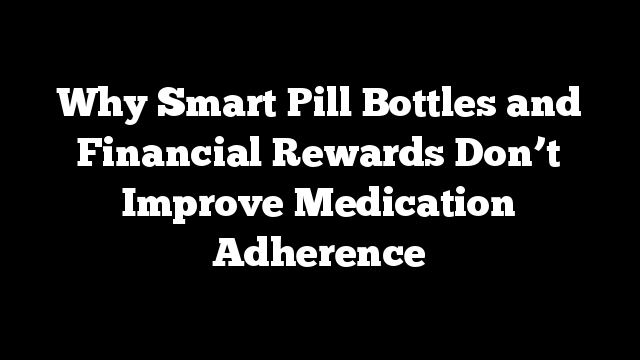 A study published recently in JAMA Internal Medicine showed financial rewards and connected pill bottles don’t work. One explanation suggests that “other patient concerns about potential adverse effects of these medications, such as impotence or fatigue, were not targeted by this engagement strategy.”
A study published recently in JAMA Internal Medicine showed financial rewards and connected pill bottles don’t work. One explanation suggests that “other patient concerns about potential adverse effects of these medications, such as impotence or fatigue, were not targeted by this engagement strategy.”
What?!!!!!??
How can a patient engagement strategy not target the patient’s concerns? Isn’t that the very definition of patient engagement? Impotence and fatigue are a big deal to most people. Would an extra $15 a week compel you to take a medication that made you impotent? $150 a week? Would a pulsating pill bottle in your cabinet get you to swallow a pill that made you feel foggy and tired all day?
We can’t incent or remind someone to do something they never agreed to or intended to do. It would be like Amazon pinging you to buy something you would never consider adding to your cart. Amazon nudges you to buy things that you would put in your cart or things you saved to your cart, but never purchased. Why aren’t we as laser-focused on what matters to patients?
When 1/2 of all people prescribed a medication do not adhere to their plan, we have to consider that they never agreed to it or recognized its importance in the first place. They didn’t forget. (Psychologists, myself included, don’t believe in “forgetting.”) Even the most “forgetful” people do not forget to eat or have sex.
You forget what you don’t want to do. Forgetting is a way of saying “no.” Patients don’t say no to their physician’s face, but they say “NO!” en masse when they don’t fill their prescription or fill it but don’t take it. When I wrote a post recently about the importance of welcoming the patient’s resistance to their care plan, some responded that I wasn’t recognizing the dangers of non-compliance. This couldn’t be further from the truth. I am simply not deluded that we can control, coerce, enforce or even educate our patients into compliance. In light of the recent JAMA Internal Medicine article, we need a different approach.
The Paradox
If we let patients say “no” to their treatment plans, they are more likely to say “yes.”
When they say “yes,” they are more committed.
The conclusion: Let them say “no,” if we want better results.
The physician is the expert at prescribing medication; patients are the experts on why they won’t take it.
I have spent my career working with patients who are making decisions that will determine whether they live or die, whether they lose limbs to disease, contract diseases that can kill them or destroy their lives and bodies through addiction. It’s a harrowing drive on a road with hairpin turns.
We clinicians are in the passenger seat no matter what we do. And the driver has never been down this road before.
When I teach residents in psychiatry, I tell them that learning to let patients drive is like training yourself to accelerate into a skid on an icy road. At first, every muscle in your body wants to resist, pull away, brake, as you feel the loss of control when the car slips on the ice. Then, you remember the facts: you are supposed to accelerate into the skid, so you let go off your tight grip on the wheel, you accelerate, you hang in the balance horribly for an instant and then the car rights itself almost effortlessly. And then, you realize you never held the wheel at all, you were in the passenger seat the whole time working with an imaginary set of controls! It takes years of experience and profound discipline to accelerate into these skids with our patients.
How does a patient-driven approach work in practice?
In 15 minute visits, providers need to get right to the point, by saying things like:
Dr. S: Look, I am prescribing this medication because I believe it can help you, but 1/2 of patients don’t end up taking it. So, before I give you this prescription, tell me all the reasons you might not take this medication and how this plan we just made is going to fail.
Patients will be surprised by this. Good! The surprise gets them thinking and engaged. They are being called on as the expert in their own care.
Mr. X: No, I am going to take it. I know I need to.
Dr. S: Some people who take this medication say it affects their sex drive and it makes them feel foggy. What will you do if that happens to you?
Mr. X: Seriously? Well, first, I am going to be very mad at you, Dr. Smith (laughs). No, but I get it, it’s important. I guess I could come back you? I’m not saying I would like it if that happens, I might have to come back to you though if that happens.
Dr. S: Of course you can come back to me. But I can’t promise that I can solve it.
Mr. X: Are there any other options? I’ve heard some people change ____ and they don’t have to take any medication at all.
Dr. S: Yes, we can talk about that and they might reduce the amount of medication you have to take and some of the side effects, but you likely still have to take medicine.
What just happened? The doctor acknowledged the patient was the one behind the wheel, the patient was surprised but intuitively started driving and making decisions and commitments. By letting the patient say no, the doctor let the patient say yes. And the patient’s yes is a critical step to improving adherence. The patient starts making suggestions, problem-solving, and asking for alternatives. This is one interaction that needs to be repeated again and again.
Patients don’t need reminders, extrinsic motivators, or incentives. They need help identifying intrinsic motivations and personal barriers, and they need their internal problem-solving abilities mobilized. All of our well-meaning education, instructions and attempts at coercion are noise from the passenger seat – distracting the driver.
What does this mean for digital health?
Digital health technologies are not doomed, in fact, this study marks a major turning point. We see what doesn’t work and we can move on. Fail fast and learn.
Digital technologies are well-suited to a patient-driven approach. At Vital Score, we have turned a disciplined patient-driven methodology into a codified method of delivering thousands of digital conversations with patients. We call our method Motivational Indexing™ because we capture and categorize what motivates people, we let them navigate a pathway to health, and we learn from the paths they create. Motivational Indexing™ works because it learns from the experts on non-adherence: patients.
We should welcome the news that reminders and incentives don’t work. It turns out the experts in medication adherence are not behavioral economists, physicians (or psychologists!). The experts are patients and we will learn if we listen to them.
Hilary Hatch is Founder and CEO of Vitalscore.
